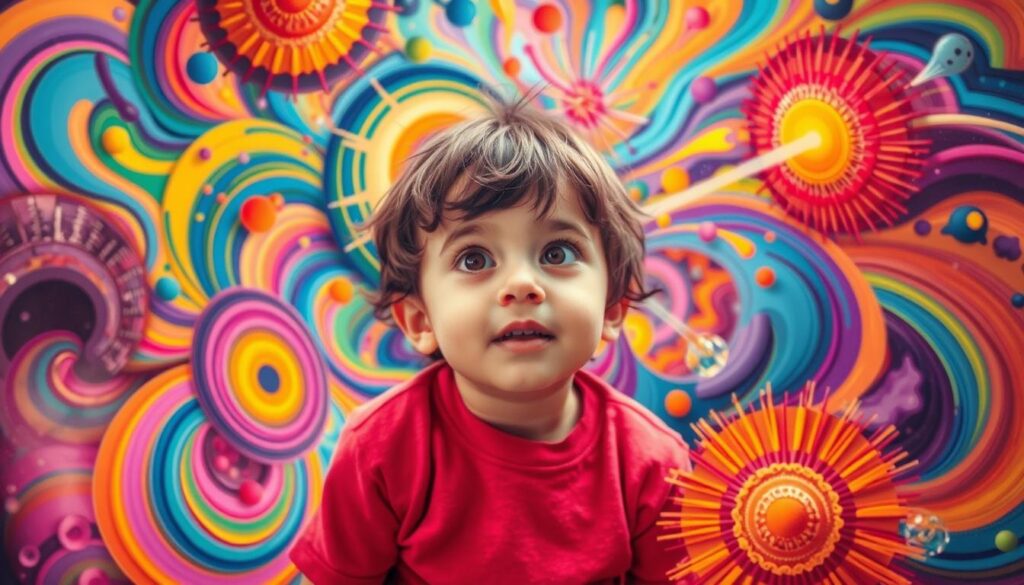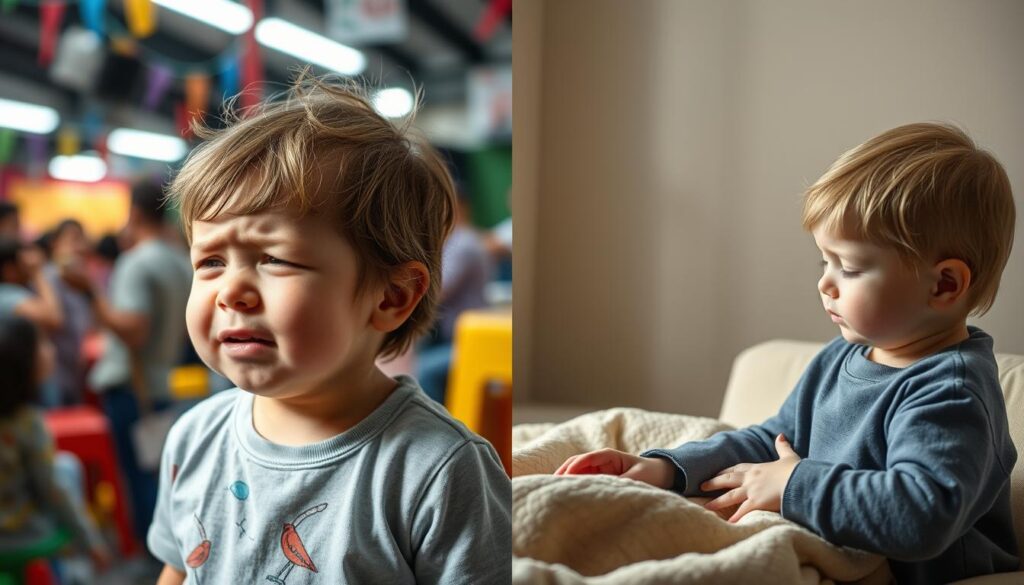Sensory issues are a key part of autism spectrum disorder. They’re so common that they’re included in the diagnostic criteria. Each autistic person has unique sensory sensitivities.
Autistic individuals may experience hypersensitivity or hyposensitivity to various stimuli. These can include sights, sounds, smells, tastes, touch, and body awareness. Such differences can affect daily life and self-regulation1.
Supporting autistic people involves understanding and accommodating their sensory needs. This approach is crucial for helping them navigate everyday situations effectively.

Key Takeaways
- Sensory issues are a core feature of autism spectrum disorder.
- Autistic individuals can experience both hypersensitivity and hyposensitivity to various sensory inputs.
- Sensory processing differences can significantly impact an autistic person’s daily functioning and self-regulation.
- Accommodating sensory needs is essential for supporting autistic individuals in their everyday activities.
- Occupational therapy, sensory integration therapy, and other resources can help address sensory processing challenges.
What is Sensory Processing in Autism?
Sensory processing is how our nervous system handles messages from our senses. For autistic individuals, sensory processing differences are a key feature. These differences are part of the diagnostic criteria for autism spectrum disorder2.
Autistic people may be over or under-responsive to sensory inputs. This includes sights, sounds, smells, tastes, touch, balance, and body awareness2. These differences can greatly affect an autistic person’s daily life and behavior.
Sensory Issues and Autism Diagnostic Criteria
Sensory processing differences are now part of the autism spectrum disorder diagnosis3. Autistic individuals show reduced interaction between brain hemispheres compared to non-autistic people. They also have specific sensory processing deficits3.
Studies show that 94% of autistic children have sensory challenges. Additionally, 70% have impaired adaptive skills due to atypical sensory modulation3. These issues can greatly impact their daily functioning.
Overwhelming sensory input can cause stress, anxiety, and physical pain for autistic individuals. This may lead to withdrawal, distress, or meltdowns2. They might experience fragmented vision, heightened sound perception, or varied tactile sensitivities.
Some autistic people may have unique sensory responses. These can include licking objects to explore textures or strongly disliking certain smells. Others might seek specific tactile sensations for comfort2.
Interestingly, some autistic individuals experience synaesthesia. This rare condition causes one sensory input to trigger experiences in another sense2. For example, they might see colors when hearing sounds.

Therapies like music, occupational, and speech therapy can help with sensory processing differences. These interventions use sensory stimuli to develop skills and independence3. Tools like colored filters or digital apps may also help with sensory sensitivities.
Understanding sensory processing differences is crucial for supporting autistic individuals. It helps improve their quality of life and daily functioning23.
Types of Sensory Processing Differences
Hypersensitivity and Hyposensitivity to Sensory Input
Autistic people often experience sensory processing differences. These can include both hypersensitivity and hyposensitivity to various inputs4. Studies show significant differences in sensory processing between autistic and non-autistic children4.
Hypersensitivity can cause sensory avoidance. People may try to escape overwhelming stimuli like bright lights or loud noises5. Some with Sensory Processing Disorder (SPD) are highly sensitive to certain inputs5.
Hyposensitivity can lead to sensory seeking behaviors. This might include constant movement or craving deep pressure5. Those with SPD may have reduced sensitivity and seek intense sensory experiences5.
Understanding an autistic person’s sensory profile is key. It helps provide the right support and accommodations45. Special questionnaires can identify unique sensory features in young children with autism4.
| Sensory Processing Differences | Hypersensitivity | Hyposensitivity |
|---|---|---|
| Characteristics | Overwhelming response to sensory stimuli, leading to sensory avoidance | Reduced sensitivity, resulting in sensory seeking behaviors |
| Examples | Discomfort with bright lights, loud noises, certain textures | Constant movement, making loud noises, craving deep pressure |
| Impacts | Difficulties in daily activities, social interactions, and participation | Challenges in regulating sensory input and adapting to environments |

“Understanding sensory processing differences is crucial for providing appropriate support and accommodations for autistic individuals to thrive in their daily lives.”
Recognizing sensory processing differences is vital. It helps create effective strategies for autistic individuals’ unique needs5. This understanding can greatly improve their daily lives and experiences.
Sensory Experiences of Autistic Individuals
Autistic individuals face unique challenges due to sensory processing differences. Over 96% of autistic children report sensitivities in multiple domains. These issues cause physical discomfort, anxiety, and difficulties managing everyday tasks.
Autistic people can experience both hypersensitivity and hyposensitivity to sensory stimuli. About 90% process sensory information differently. This leads to various challenges in their daily lives.
Hypersensitivity can trigger sensory overload, causing distress and meltdowns. Hyposensitivity may result in decreased pain sensitivity and poor balance. It can also make it hard to focus on surroundings.
These sensory experiences affect many aspects of an autistic person’s life. They impact school, work, household tasks, and even parenting. Many face a lack of understanding from others about their sensory discomfort.
Understanding these unique sensory experiences is crucial for providing effective support. It helps create more inclusive environments. Sensory integration therapy and environmental modifications can be helpful approaches.
Coping strategies and gradual exposure with consent are also suitable for addressing sensory issues. By meeting these needs, we can help autistic individuals navigate life more easily.
| Sensory Processing Difficulty | Challenges | Management Strategies |
|---|---|---|
| Hypersensitivity | Sensory overload, anxiety, distressed behavior, meltdowns | Noise-cancelling headphones, dimming lights, varied food options, weighted blankets |
| Hyposensitivity | Decreased pain sensitivity, poor balance, difficulty paying attention | Movement, weighted blankets, intense flavors, sensory stimulating toys |
“Sensory processing challenges significantly impact the daily lives of many autistic individuals.”15
autism sensory processing
Autism spectrum disorder (ASD) often involves unique sensory processing experiences. Up to 90% of individuals with ASD also have sensory processing issues9. These differences can greatly affect an autistic person’s daily life, emotions, and social interactions.
Sensory processing disorder (SPD) affects how the brain handles various sensory inputs. It impacts 5%–16% of children in the United States10. Up to 16% of the general population may experience sensory processing irregularities9.
SPD occurs in about 90% of people living with ASD10. People with developmental delay, intellectual disability, and ADHD can also face sensory processing challenges9.
Autistic individuals may experience hypersensitivity or hyposensitivity to sensory inputs10. A 2017 study found larger gray matter volumes in early sensory brain regions of children with ASD and SPD10. This suggests a potential neurological basis for these sensory processing differences.
A 2013 study revealed white matter abnormalities in brain areas related to sensory processing in children with SPD10. A 2014 study found similar white matter disruption in sensory pathways of children with SPD and ASD.
Understanding autistic individuals’ sensory processing profiles is crucial for providing appropriate support. In 2020, 1 in 36 eight-year-olds in the U.S. received an ASD diagnosis10. ASD is four times more likely in children assigned male at birth10.
Addressing sensory needs through tailored interventions like occupational therapy can empower autistic individuals. This approach helps them manage sensory experiences and thrive in daily life. Supporting unique sensory processing profiles fosters overall well-being and inclusion in society.
Accommodations for Sensory Differences
Many people with autism have sensory processing differences. This also affects those with anxiety, ADHD, and PTSD11. Meeting these sensory needs can boost comfort and participation.
It can help autistic individuals learn, socialize, and communicate better. They’ll also find it easier to engage in community activities.
Examples of Accommodations for Different Sensory Needs
Accommodations can involve changing the environment or using helpful tools. They may also include creating new habits and routines.
For hypersensitive individuals, light covers, sunglasses, or earplugs can help. Working in quiet spaces and avoiding strong scents are also useful11.
Hyposensitive people may benefit from fidget toys and movement breaks. Weighted blankets or clothing can also be helpful11.
Many offices now ban fragrances to help those with sensory sensitivities11. Planning outings for friends with sensory differences requires extra steps.
Scouting locations beforehand can ensure a suitable experience11. Various venues now offer sensory accommodations for all ages.
Sports stadiums, theaters, museums, and malls are becoming more inclusive11. Businesses can use social narratives, videos, and photos on their websites.
This info helps people with sensory differences understand the environment11. It’s crucial to publicize accessibility options and adaptations.
This ensures people know about available accommodations11. Special shopping hours for neurodivergent adults can boost inclusivity in retail settings11.
Sensory processing difficulties affect 45% to 95% of people with ASD12. Age, IQ, and study control groups influence these numbers.
Research suggests autism may increase the likelihood of experiencing synesthesia12. Sensory hypersensitivity is common in autistic individuals.
This leads to heightened sensitivity to lights, sounds, smells, textures, and tastes12. Sensory hypo-sensitivity is also prevalent in autism.
It causes decreased sensitivity to sensory input. People with this tend to seek more stimulation12.
Many autistic individuals experience both hypersensitivity and hyposensitivity12. These sensory issues relate to autistic traits and social challenges.
Sensory overload can result from intense stimuli. It may cause anxiety, escapism, and communication difficulties12.
Sounds, lights, touch, or smells can trigger overload. Stimming behaviors are common in autism.
These repetitive movements or sounds help with self-regulation. They’re used to cope with stress and sensory imbalance12.
Sensory Integration Therapy (SIT) aims to improve sensory processing in autism. It uses custom interventions and sensory-based activities12.
Environmental changes are crucial for managing sensory challenges. Adapting surroundings helps create a sensory-friendly environment for autistic individuals12.
Self-Advocacy for Sensory Needs
Empowering my autistic child to self-advocate for their sensory needs is crucial. Autism often brings unique sensory processing differences. Understanding how to communicate these needs is vital for my child’s well-being and success.
Helping my child identify their sensory preferences and triggers is key. This self-awareness allows them to express their needs clearly. They can ask for quiet spaces, preferred textures, or breaks when overwhelmed14.
We develop strategies to share with teachers and other support systems. These may include noise-cancelling headphones or access to sensory-friendly rooms. Regular sensory breaks are also important14.
Autism Speaks’ Self-Empowerment Roadmap and Employment Toolkit have been invaluable resources. They provide tools for self-advocacy and boost confidence. These guides help my child understand their rights and navigate various settings14.
The aim is to nurture a self-assured advocate. My child learns to communicate their sensory needs effectively. This enhances their quality of life and fosters independence14.
“Empowering my child to self-advocate for their sensory needs has been a game-changer. It has not only improved their quality of life but has also instilled a sense of confidence and independence that will serve them well in the future.”
Therapies and Resources for Sensory Processing
Autistic individuals can access various therapies to manage sensory processing differences. Occupational therapy teaches strategies for handling sensory challenges in daily life15. Speech therapy addresses sensitivities affecting speech and swallowing15.
Feeding therapy helps with food texture aversions16. Cognitive behavioral therapy aids in managing anxiety and increasing sensory tolerance15. Sensory-friendly events offer comfortable community participation opportunities15.
Therapists use listening programs with special CDs and headphones for sensory challenges16. Sensory integration (SI) therapy involves a “sensory diet” for home use16. Home and school adaptations include quiet spaces and reduced visual clutter16.
- Weighted vests, blankets, fidget toys, chewable “jewelry,” and pressure garments provide regulating input16.
- Sensory lifestyle interventions help manage sensory issues and developmental delays in children with sensory processing disorder (SPD)16.
Research explores new ways to measure auditory sensitivities in autistic individuals15. The study “Characterizing Auditory Sensory Stability in Autism” develops methods to assess these sensitivities15. It uses daily self-reports and remote tasks to understand symptom relationships15.
| Therapy | Focus | Benefits |
|---|---|---|
| Occupational Therapy | Strategies for managing sensory differences in everyday environments | Helps autistic individuals develop coping mechanisms and adaptations to navigate sensory challenges |
| Speech Therapy | Addressing sensitivities or under-sensitivities that impact speech, swallowing, and related muscle movements | Improves communication and oral-motor functioning for those with sensory processing difficulties |
| Cognitive Behavioral Therapy | Managing anxiety and increasing tolerance to overwhelming sensory experiences | Enhances emotional regulation and resilience in the face of sensory challenges |
“Sensory processing challenges significantly impact the daily lives of many autistic individuals.”15
Sensory Processing and Daily Life
Impact of Sensory Differences on Daily Activities
Daily life can be tough for people with autism due to their sensory processing differences17. Studies show that 68.8% of autistic children face sensory issues, compared to 21.5% of typical kids17. These differences can make simple tasks like going to school or work very hard17.
Some autistic people are extra sensitive to sights, sounds, or textures18. This can make everyday places very stressful. Others may not feel enough, causing problems with movement or recognizing body signals18.
Luckily, there are ways to help18. Regular routines, therapy, and emotional support can make a big difference. These tools can help autistic people manage their sensory challenges better18.
By understanding autistic people’s sensory needs, we can create better spaces for them1718. This can help them feel more at ease in their daily lives. With the right support, autistic individuals can thrive in various settings.
| Sensory Processing Difficulty | Impact on Daily Activities |
|---|---|
| Hypersensitivity to Sounds | Difficulty tolerating noisy environments like classrooms or workplaces, leading to stress and avoidance |
| Hyposensitivity to Touch | Challenges with fine motor skills, such as buttoning clothes or using utensils, impacting self-care and independence |
| Sensory Overload | Overwhelming experiences in crowded or stimulating settings, resulting in meltdowns or withdrawal |
Understanding and Supporting Sensory Needs
Understanding your autistic child’s sensory processing is key to providing proper support. Creating a sensory profile helps identify their sensitivities and preferences. This allows you to make smart choices about their environment and tools19.
Over 96% of autistic children are hypersensitive to sensory input. This can cause stress, anxiety, and behavioral meltdowns. Some autistic individuals may seek more sensory input, showing hyposensitivity19.
Addressing sensory needs can greatly improve an autistic child’s emotional regulation and daily activities. It can also enhance their community engagement20.
Team up with educators and therapists to create a sensory-friendly space for your child. This might involve adjusting lighting, reducing noise, or introducing fidget toys. Weighted blankets can also help your child feel more comfortable20.
Supporting your autistic child’s sensory needs empowers them to thrive confidently. Remember, each child is unique. A personalized approach is crucial for unlocking their full potential1920.
| Sensory Sensitivity | Hypersensitivity | Hyposensitivity |
|---|---|---|
| Visual | Difficulties with bright lights or visual chaos | Seeking out more visual stimulation, such as flashing lights or spinning objects |
| Auditory | Noticing background noises that others might overlook | Enjoying loud music or specific sounds close to their ears for comfort |
| Olfactory | Finding certain smells unpleasant | Seeking out specific smells |
| Gustatory | Discomfort with certain tastes or textures, affecting food choices | N/A |
| Tactile | Discomfort with physical contact, particular textures, or clothing | N/A |
“By addressing sensory needs, autistic individuals can better regulate their emotions, participate in daily activities, and engage in their communities.”
Research and Advancements in Sensory Processing
Ongoing research reveals new insights into sensory processing differences in autism. Studies use advanced methods to explore unique sensory experiences of autistic individuals. These studies show how their brains process and respond to various inputs21.
Recent research found that Sensory Processing Disorder (SPD) affects 5-16% of school-aged children. Over 80% of children with autism spectrum disorder (ASD) also have SPD. About 90% of individuals with ASD are diagnosed with SPD21.
Studies have found differences in brain connectivity between children with ASD and those with SPD. This highlights the complex nature of sensory processing differences21.
Various healthcare professionals play a crucial role in diagnosing SPD. These include developmental doctors, mental health experts, and occupational therapists21.
Researchers are developing specialized therapies like sensory integration therapy. They’re also designing sensory-friendly environments to support autistic individuals. These efforts aim to help manage sensory needs and improve quality of life21.
A recent study involved 61 autistic and 72 non-autistic children, averaging 8 years old. It found a link between brainstem structure and sensory responses in autistic children22.
The brainstem and cerebellum make up only 7% of the search space. Yet, they contribute to 21% of the findings related to sensory features22.
Ongoing research promises more advances in understanding sensory processing in autism. This may lead to better interventions and support strategies for autistic individuals2122.
Conclusion
Sensory processing differences affect up to 90% of autistic individuals23. These challenges can greatly impact daily life, social interactions, and overall well-being23. Understanding and accommodating these needs can help autistic individuals thrive and reach their full potential.
Up to 95% of young autistic children show extreme sensory symptoms24. Recognizing this is vital for providing proper support and interventions24. Therapies like Sensory Integration and Applied Behavior Analysis can make a big difference.
Practical strategies such as sensory diets and sensory-friendly environments are also helpful23. These approaches can improve the lives of autistic individuals significantly.
Autism spectrum disorder rates have risen from 1 in 150 to 1 in 54 children since 200024. It’s crucial to deepen our understanding of sensory processing differences. By addressing unique sensory needs, we can promote inclusion and independence for the autism community24.
FAQ
What are sensory processing differences in autism?
Sensory processing turns messages from our senses into responses. Autistic individuals may be over- or under-responsive to sensory inputs. This affects how they experience sights, sounds, smells, tastes, touch, balance, and body awareness.
How do sensory processing differences impact autistic individuals?
These differences can greatly affect an autistic person’s daily life, emotions, and behavior. Hypersensitivity may lead to avoiding certain sensations. Hyposensitivity can cause seeking out intense sensory experiences.
Sensory overload might trigger anxiety, emotional distress, and meltdowns. This can make everyday activities challenging for autistic individuals.
What are the types of sensory processing differences in autism?
Autistic individuals can experience both hypersensitivity and hyposensitivity, often together. These differences shape how they interact with their environment.
How can sensory needs be accommodated for autistic individuals?
Accommodations involve changing the environment, using helpful tools, or creating new routines. For hypersensitivity, light covers or earplugs can help. Hyposensitivity accommodations might include fidget toys or movement breaks.
How can autistic individuals advocate for their sensory needs?
Self-advocacy starts with understanding one’s sensory processing profile and effective accommodations. Autistic individuals can then work with others to address their needs.
This includes collaborating with employers, educators, and support teams. Clear communication about sensory needs is key.
What therapies and resources are available for managing sensory processing differences?
Various therapies can help autistic individuals process sensory input better. These include occupational, speech, feeding, and cognitive behavioral therapy.
Sensory-friendly events and resources also provide more comfortable environments. These support autistic individuals in managing their sensory experiences.
How do sensory processing differences impact an autistic person’s daily life?
Daily activities can be draining and stressful for autistic individuals with sensory differences. School, work, and community settings may pose unique challenges.
Proper accommodations and support are vital. They help autistic people navigate their daily routines more comfortably.
How can caregivers and support providers better understand and address sensory needs?
Creating a sensory profile helps identify specific sensitivities and preferences. This information guides environmental changes and introduces helpful sensory tools.
It also helps prepare individuals for potential sensory challenges. Understanding these needs improves support for autistic people.
What advancements are being made in the understanding of sensory processing in autism?
Ongoing research deepens our knowledge of sensory processing in autism. This informs the development of specialized therapies and sensory-friendly environments.
These advancements help autistic individuals manage their sensory needs better. The goal is to improve overall quality of life for autistic people.
Source Links
- https://www.autismspeaks.org/sensory-issues – Sensory Issues | Autism Speaks
- https://www.autism.org.uk/advice-and-guidance/topics/sensory-differences/sensory-differences/all-audiences – Sensory differences – a guide for all audiences
- https://www.ncbi.nlm.nih.gov/pmc/articles/PMC10687592/ – Sensory Processing Differences in Individuals With Autism Spectrum Disorder: A Narrative Review of Underlying Mechanisms and Sensory-Based Interventions
- https://www.ncbi.nlm.nih.gov/pmc/articles/PMC3086654/ – Sensory Processing in Autism: A Review of Neurophysiologic Findings
- https://www.abtaba.com/blog/sensory-processing-disorder-vs-autism – Sensory Processing Disorder vs. Autism
- https://www.psychologytoday.com/us/blog/women-autism-spectrum-disorder/202208/how-autistic-people-experience-sensory-processing-issues – How Autistic People Experience Sensory Processing Issues
- https://www.autistica.org.uk/what-is-autism/anxiety-and-autism-hub/sensory-differences – Sensory differences | Autistica
- https://www.linkedin.com/pulse/understanding-sensory-processing-autism-limitations-uiqgc – Understanding Sensory Processing in Autism and the Limitations of Exposure Therapy
- https://www.ivyrehab.com/news/sensory-processing-vs-autism-whats-the-difference/ – Sensory Processing vs Autism: What’s the Difference? | Ivy Rehab
- https://www.medicalnewstoday.com/articles/sensory-processing-disorder-vs-autism – Sensory processing disorder vs. autism: Differences explained
- https://www.fraser.org/resources/blog/here-are-5-ideas-to-better-accommodate-adults-with-sensory-processing-differences-in-the-community- – Here are 5 Ideas to Better Accommodate Adults with Sensory Processing Differences in the Community
- https://www.abtaba.com/blog/autism-sensory-processing – Coping with Autism Sensory Processing
- https://www.autismspeaks.org/tool-kit-excerpt/teaching-autism-self-advocacy – Teaching Your Child Self-Advocacy | Autism Speaks
- https://tacanow.org/family-resources/self-advocacy/ – Self-Advocacy
- https://autism.org/sensory-processing-resources/ – Sensory Processing Resources
- https://childmind.org/article/treating-sensory-processing-issues/ – Treating Sensory Processing Issues – Child Mind Institute
- https://www.ncbi.nlm.nih.gov/pmc/articles/PMC10071971/ – Sensory processing and its relationship to participation among childhood occupations in children with autism spectrum disorder: exploring the profile of differences
- https://tacanow.org/uncategorized/sensory-processing-disorder-in-autism/ – Sensory Processing Disorder in Autism
- https://behavioral-innovations.com/blog/understanding-and-supporting-sensory-needs-in-autism/ – Sensory Processing with Autism | Behavioral Innovations
- https://www.autismspeaks.org/tool-kit-excerpt/supporting-sensory-needs-school – Supporting sensory needs at school | Autism Speaks
- https://www.brighterstridesaba.com/blog/sensory-processing-disorder-vs-autism – Sensory Processing Disorder vs. Autism Explained
- https://www.waisman.wisc.edu/2023/04/05/sensory-responses-in-autistic-children/ – Sensory responses in autistic children are linked to a small under-explored region tucked deep down in the brain called the brainstem
- https://sachscenter.com/sensory-processing-disorder-spd-and-autism/ – Sensory Processing Disorder and Autism: How Are They Connected? – Sachs Center | ADHD & Autism Testing and Treatment
- https://www.frontiersin.org/journals/psychiatry/articles/10.3389/fpsyt.2021.695825/full – Frontiers | Implications of Sensory Processing and Attentional Differences Associated With Autism in Academic Settings: An Integrative Review


